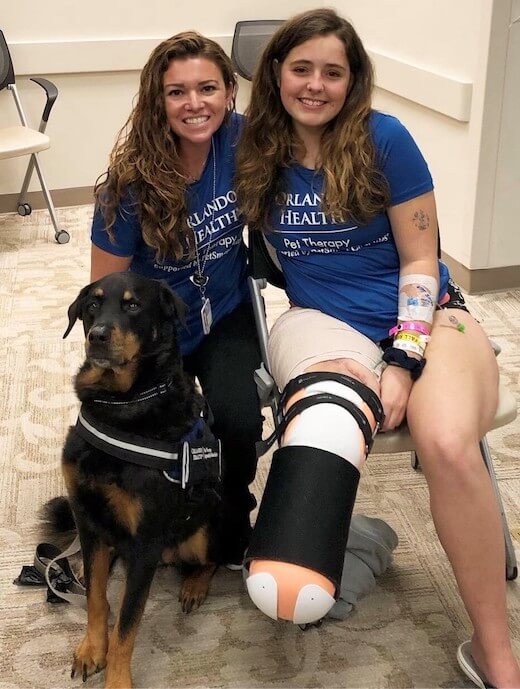Four-Legged Visitors Encourage Orlando Health Patients

If you spend any time getting medical treatment, the team at Orlando Health would like you to have at least one visitor with a cold nose and a wagging tail. It could be for a quick cuddle during a long day of chemotherapy or an encouraging nudge during a difficult rehab session.
The newest member of the healthcare system’s canine corps is Parks, an expressive 2-year-old yellow Labrador retriever who recently became a facility dog at Orlando Health Arnold Palmer Hospital for Children.
During his specialized training, Parks mastered more than 40 commands that enable him to interact with and calm patients. He can perform helpful tasks like pulling open a door, turning on a light switch with his nose and retrieving items. As a facility dog, Parks is certified through a national standardized test and must return periodically for follow-up assessments.
Trained by Canine Companions, which has a regional center in Orlando, Parks works 40 hours a week as part of Orlando Health Arnold Palmer’s child life team. Monday through Friday, he helps relieve anxiety, stress and fear for chronic and critically ill children and their families. He also serves as a motivator for patients to reach certain goals and milestone.
“We do a lot of medical play, desensitizing kids to medical equipment, as well as regular play,” says Orlando Health Child Life Specialist Kim Burbage, Parks’ on-site handler with whom Parks lives.
“He kind of has two personalities,” says Burbage. “When he has the working collar and vest on, he’s definitely more serious. But at home, he definitely has his playful side.”
‘This Is Needed’
In addition to Parks, the healthcare system has a Pet Therapy Program made up of dogs of various breeds and sizes alongside their handler owners.
With 30 breeds from a miniature Yorkie to a massive Burmese Mountain Dog, the therapy unit has 62 dog/owner teams. The program has set a goal of growing to at least 100 teams.
“What everyone in the dog world has known for years is that this is needed,” says Kim Bissing, Orlando Health pet therapy coordinator. “We have so many patients who want it.”
All volunteers — dogs and owners alike — must be certified by one of three national groups responsible for training: Alliance of Therapy Dogs, Pet Partners and Therapy Dogs International. Once accredited, the teams gain access to a long list of visit requests.
Assignments include room visits, corporate events, trips to chemotherapy treatment rooms and hospice hellos.
Every dog has its sweet spot, says Bissing, a former dolphin trainer at SeaWorld. Some are better one-on-one. Others prefer to work in a crowd. Some prefer children. Others light up with adults.
The Dogs Know
Doctors and nurses can order pet therapy for their patients. And patients get their say, too. They can request a specific breed — just like the one they left at home or maybe like the one they grew up with.
The list of requests far outnumbers the volunteer teams in place. Some teams take one or two assignments a month. Most accept up to one a week.
“They’re very much in demand,” Bissing says of her volunteers.
Bissing, who owns three pet therapy dogs, understands the need. She has often witnessed something amazing: a volunteer dog en route to an assigned patient but first pulling its owner to someone else in the lobby.
“That person needs it, and the dog knows,” Bissing says. “Dogs don’t judge. They’re going to walk up wagging their tail. The person didn’t even realize they needed something so loving or caring. But dogs get through to them on their own.”









